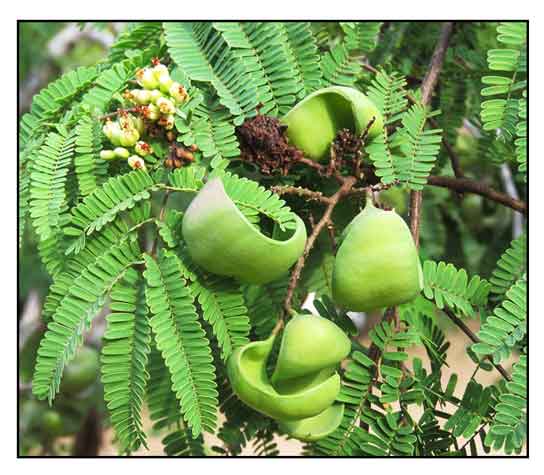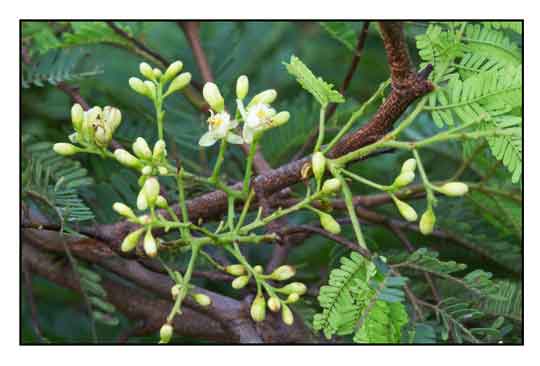 Botany Botany
Caesalpinia coriaria is a crooked and spreading shrub or small tree, unarmed, growing to a height of 10 meters. Leaves are alternate, bipinnate, the pinnae in 3-9 pairs. Leaflets in 12-28 pairs per pinna, sessile-linear, 4-10 millimeters by 1to 2.5 millimeters, with black dots underneath. Flowers are bisexual and fragrant, yellow or cream colored, sepals 3 to 4 millimeters long, petals 3 to 6 millimeters long. Fruit is an indehiscent pod, often twisted, 5 to 9 centimeters by 1 to 3 centimeters, pale to blackish brown, 1- to 10-seeded. Seeds are glossy brown, ellipsoid or reniform, 6 to 7 millimeters long. (1)
Distribution
- Introduced
- Native to tropical American and the West Indies.
- Introduced as an ornamental in other tropical regions.
 Constituents Constituents
- Pods are rich in tannin.
- Phytochemical analysis of acetone extract of pods yielded tannins, carbohydrates, flavonoids, glycosides, and betacyanin, with absence of anthocyanins, amino acids, protein, alkaloids, and saponins.
(see study below) (3)
- A bioactive fraction (EtOAc-F) yielded two important compounds, methyl gallate (1) and gallic acid (2). (see study below) (4)
- GC-MS study of methanol extract of Caesalpinia coriaria yielded 12 compounds. Dominant compounds were Dodecadien-1-ol, n-Hexadecanoic acid, Tridecanoic acid, and Hexadecanoic acid. (see study below) (10)
- Study of various extracts of pods (acetone, aqueous, ethyl acetate, ethanol) yielded tannin, quinones, carbohydrates, saponins, flavonoids, glycosides, cardiac glycosides, terpenoids, phenols, coumarins, proteins, steroids, anthraquinones, polyphenols, among others. (see study below)
(14)
Properties
- Studies have suggested antibacterial, corrosion inhibitory, anthelmintic, anticancer, anthelmintic antioxidant, anti-diabetic properties.
Parts used
Pods.
Uses
Folkloric
- No reported folkloric medicinal use in the Philippines.
- Pods
used as antiperiodic and for dressing sores. (1)
- Used in Mexico as cicatrizant and anti-inflammatory.
(0)
Others
- Tannin: Pods rich in tannin. Used as blend for tanning leather.
- Dye: Pods yield a blackish or bluish dye for cotton and wool; black ink used in decoration of traditional potteries and gourds in Central America. Used as mordant for dyeing vegetable fibers with other dyes. In India, wood used as source of a red dye. (1)
- Mulch: Leaves used as mulch. (1)
Studies
• Antibacterial / Phytopathogens / Leaf and Pod: Study evaluated various extracts of powdered leaf and pod material for antibacterial activity against important phytopathogenic Santhomonas pathovarss known to cause diseases in tomato, fresh beans, and cotton. The methanol extract of leaf and pod was most active against all test bacteria. Antibacterial activity was attributed to phenolics and acidic fraction. Results suggest C. coriaria is a potential candidate plant for the management of phytopathogenic Xanthomonas. (2)
• Antibacterial / Pod: Study evaluated the antibacterial activity of powdered pod material extracted with water, acetone, methanol, and hexane against important human pathogens like Salmonella typhimurium, Escherichia coli, Pseudomonas aeruginosa, Methicillin resistant S. aureus, and Klebsiella pneumonia. The acetone extract showed significant activity. Activity was attributed to the tannin fraction. (3)
• Antibacterial / Fruit: Study sought to isolate and identify secondary metabolites with antibacterial activity from the fruit of C. coriaria. A bioactive fraction (EtOAc-F) yielded two important compounds, methyl gallate (1) and gallic acid (2). On antibacterial testing, gallic acid (2) showed the lowest MIC on S. typhi (0.156 mg/mL), L. monocytogenes and S. aureus (1.25 mg/mL). Methyl gallate (1) showed best inhibitory effect against E. coli and P. aeruginosa (1.25 mg/mL). (4)
• Corrosion Inhibition / Fruit: Study evaluated the corrosion inhibition effect of C. coriaria pods extract on mild steel in 1M HCl and H2SO4 Results showed C. coriaria extract contains antioxidants and acted as an effective inhibitor in the acid media. (5)
• Anthelmintic / Fruit: Haemonchus contortus is one of the most common pathogenic parasites affecting the health of small ruminants. Study evaluated the in vitro lethal effect of a methanolic extract of C. coriaria fruits against Haemonchus contortus eggs and infective larvae. Results showed the ME of fruit possesses in vitro ovicidal and larvicidal properties against H. contortus. Phenolic compounds such as methyl gallate and its derivatives may be responsible for the anthelmintic effect.(6)
• Isolation of Tannins: Study reports on the influence of particle size, temperature, methanol content and time on the extraction of tannins from C. coriaria by pressure autoclaving method. (7)
• Flavonoids and Glycosides / Bactericidal: Study identified bioactive compounds and evaluated their antibacterial mode of action. The isolated flavonoids and glycoside were treated with E. coli, S. aureus, and K. pneumonia. Results showed disturbance in protein synthesis which may be the mechanism of its bactericidal effect. (8)
• Phenolic Compounds / Anticancer / Cell Cycle Arrest and Apoptosis / Pods: Study evaluated water acetone:ethanol (WAE) extract of C. coriaria pods for active compounds and their cytotoxic effect and cell death induction in different cancer cell lines. Chromatography and spectroscopic studies isolated stigmasterol, ethyl gallate and gallic acid. Ethyl gallate and tannic acid induced G2/M phase cell cycle arrest. Induction of apoptosis was characterized by morphological changes with increase in Bax/Bcl-2 ration and activation of caspase 3/7. (9)
• GC-MS Study / Bioactive Compounds: GC-MS study of methanol extract of Caesalpinia coriaria yielded 12 compounds. Dominant compounds were Dodecadien-1-ol, n-Hexadecanoic acid, Tridecanoic acid, and Hexadecanoic acid. Studies have shown Octadecatrienoic acid and Vitamin E have antidote, antitumor, antiproliferative, antiarthritic,antiacne, hepatoprotective properties. Most identified compounds have reported antimicrobial activity. The squalene compound has anti-cancer, anti-oxidant, anti-tumor, chemo-preventive, pesticidal. Results suggest phytopharmaceutical potential for the various bioactive compounds. (10)
• Gallic Acid / Ovicidal Against Nematodes: Study evaluated the in vivo ovicidal activity of a hydroalcoholic extract of C. coriaria fruits against gastrointestinal nematodies (GIN). The hydroalcoholic extract and EtOAc-F showed concentration dependent ovicidal activity with LC50 of 0.92 and 0.16 mg/mL, respectively. Ovicidal activity was attributed to gallic acid. (11)
• Hepatoprotective Against Carbon Tetrachloride toxicity / Antioxidant / Fruit: Study evaluated the inhibitory activity of protein carbonylation and the hepatoprotective effect of an ethanol extract of fruits in Wistar rats with CCl4-induced toxicity. Results showed antioxidant activity and moderate hepatoprotective effect against CCl4-induced toxicity. (12)
• Ovicidal / Haemonchus contortus and H. placei / Fruits and Leaves: Study evaluated the ovicidal effect of hydroalcoholic extracts from mature fruits and dried leaves of C. coriaria against Haemonchus contortus and H. placei by egg hatching inhibition test (EHIT). Results showed a concentration dependent ovicidal effect of both leaves and fruits with 100% efficacy against both nematode species with 25.0 g/mL concentration (p<0.05). (13)
• In Vitro Anticancer / SiHa Cell Lines / Pods: Study evaluated the anticancer activity of isolated phytochemicals from C. coriaria acetone, ethyl acetate, ethanol and aqueous extracts through cytotoxicity study, DNA fragmentation, cell cycle analysis, apoptosis study, caspase activity and gene expression study. Study suggests the mode of action is the basic activation of the apoptosis pathway. Free radical scavenging assays established the antioxidant potential of the four extracts. (see constituents above) (14)
• Arginase Inhibitory Activity / Antioxidant / Bark: Study evaluated the arginase inhibitory and antioxidant activities of bark extracts of C. coriaria. Ethyl acetate and methanol extracts showed average inhibition values of 14.43 and 33.59%, respectively, at 100 µg/mL concentration. Total flavonoid content were 6.30 mg and 7.75 mgQE/g, respectively. Antioxidant activity showed IC50s of 3.647 µg/mL and 4.720 µg/mL, respectively. The EA extract yielded flavonoid, tannin, saponin and steroid, while the ME yielded flavonoid, tannin, and saponin. (15)
• Silver Nanoparticles: Study reports on the ecofriendly, economical, and efficient synthesis of silver nanoparticles using an ethanolic extract of C. coriaria. (16)
• Antidiabetic / Leaves: Study evaluated various solvent extracts of dried and powdered Bauhinia malabarica leaves, Caesalpinia pulcherrima flowers and leaves and C. coriaria leaves for antidiabetic activity. Activity of all gained extracts at 8 mg/mL were compared to acarbose using an in vitro α-glucosidase inhibitory assay. Most significant inhibitory activity was detected from all ethanolic extracts ranging from 89% to 96%, while acarbose showed 84% inhibition. (17)
Availability
Wild-crafted.
|

![]()





